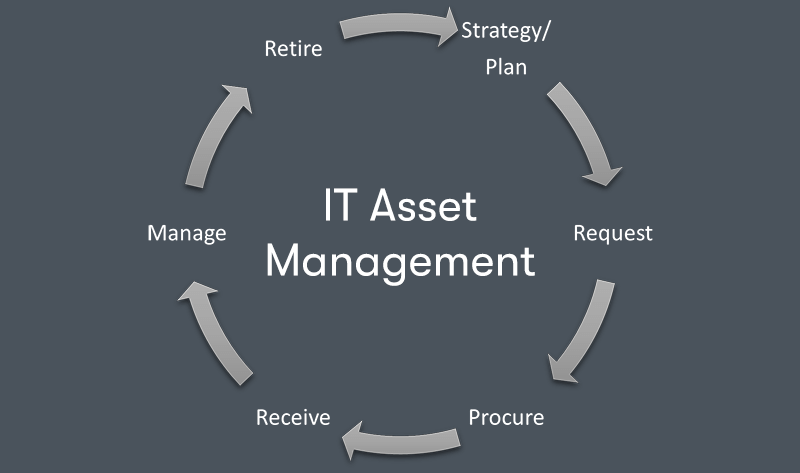What Is ITAM - IT Asset Management?
Welcome to our latest blog post, where we dive into the dynamic world of IT Asset Management (ITAM) - a pivotal component in modern business infrastructure. At its core, ITAM is the strategic and systematic approach to managing the lifecycle of IT assets. It encompasses everything from procurement to disposal, ensuring these assets are efficiently utilised, well-maintained, and effectively aligned with broader business goals.
As organisations increasingly rely on technology for day-to-day operations, the importance of ITAM in optimising investment, enhancing operational efficiency, and mitigating risk has never been more pronounced. Join us as we unravel the complexities of ITAM, explore its significance, and shed light on how it forms the backbone of effective IT infrastructure in today's digital landscape.
What is IT Asset Management (ITAM)?
IT Asset Management is a comprehensive approach to managing an organisation's technology assets throughout their lifecycle. It encompasses various activities and processes to ensure these assets are accounted for, deployed, maintained, upgraded, and disposed of effectively and efficiently. Here's a detailed breakdown of ITAM:
Definition and Scope
Assets Covered: ITAM covers all technology assets, including hardware (like servers, computers, mobile devices), software (licenses, applications), and related services.
Lifecycle Management: It involves managing the entire lifecycle of these assets from procurement to disposal.
Key Objectives
Cost Management: Reduce costs through efficient asset utilisation, purchasing, and lifecycle management.
Risk Management: Minimise risks related to compliance, software licensing, and security vulnerabilities.
Strategic Planning: Support strategic IT decision-making by providing accurate information on IT assets.
ITAM Tools and Technologies
Asset Discovery Tools: Automatically identify and record new assets within the network.
Inventory Management Systems: Track and manage asset information, including location, configuration, and usage data.
License Management Solutions: Tools for tracking and managing software licenses.
Future Trends and Evolutions
Integration with Cloud Services: As more organisations move to cloud-based services, ITAM adapts to manage these virtual assets.
Focus on Sustainability: Considering the environmental impact of IT asset disposal and lifecycle.
In summary, ITAM is an essential part of modern IT operations, providing a structured and strategic approach to managing an organisation's valuable and often complex array of technology assets.
What is an Asset in ITAM?
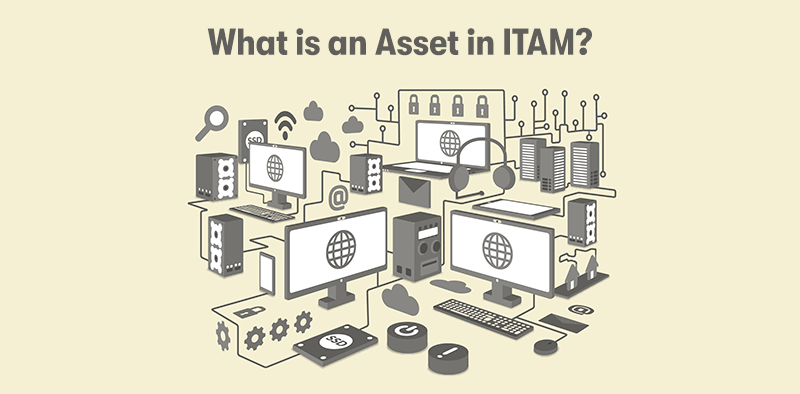
In the context of IT Asset Management (ITAM), an "asset" refers to any item of value owned by an organisation that plays a role in its IT infrastructure and operations. These assets are typically categorised into different types, requiring specific management strategies throughout their lifecycle. Here are the key types of assets in ITAM:
Hardware Assets
Computers and Laptops: Personal computing devices used by employees.
Servers: Machines that host data and applications for the organisation.
Networking Equipment: Routers, switches, and other devices that facilitate network connectivity.
Mobile Devices: Smartphones and tablets used for business purposes.
Peripherals and Accessories: Printers, monitors, external storage devices, etc.
Software Assets
Licensed Software: Commercial software products that require a purchase or subscription, such as operating systems, office suites, and specialised applications.
Open Source Software: Software with source code that is freely available for modification and distribution.
Custom-Built Software: Software developed in-house or specifically for the organisation.
Cloud-Based Applications: Software-as-a-Service (SaaS) products accessed via the Internet.
Digital Assets
Data: Information stored and processed by the organisation, such as customer data, employee information, and business intelligence.
Websites and Domains: Online properties owned by the organisation.
Service and Contractual Assets
Service Agreements: Contracts for services provided by third parties, like cloud hosting, support, and maintenance services.
Software Licenses: Agreements that dictate how software can be used and by how many users.
Warranties and Maintenance Contracts: Agreements that provide for hardware and software maintenance, support, and repair.
Key Characteristics of an IT Asset
Value: Assets are valuable resources, either in terms of money, business functionality, or both.
Accountability: They must be accounted for in the organisation's inventory and financial records.
Lifecycle Management: From acquisition to disposal, each asset undergoes various stages, including procurement, deployment, maintenance, and eventual retirement.
Risk and Compliance: Assets must be managed to minimise risk (such as security risks) and ensure compliance with various laws and regulations.
In essence, an asset in ITAM is any component of the IT environment that needs to be managed effectively to support the organisation's IT infrastructure and business goals. This management involves tracking the asset's procurement, usage, maintenance, and disposal to optimise its value and align with the organisation's overall strategy.
Why is IT Asset Management Important?
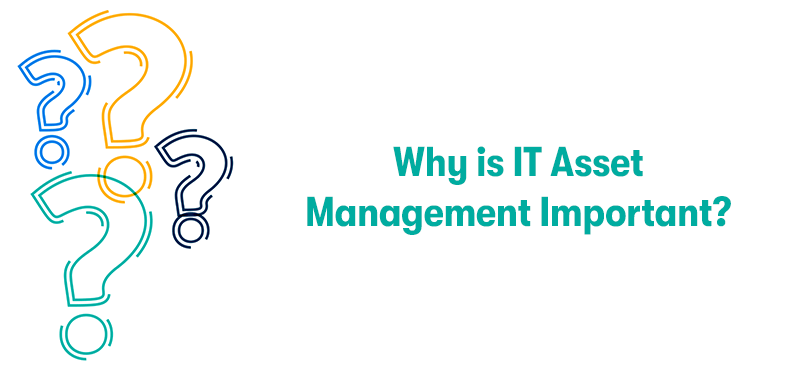
IT Asset Management (ITAM) is crucial for organisations due to several key reasons:
Cost Optimisation and Financial Management
Reduces Unnecessary Expenditure: ITAM helps identify underutilised or unnecessary assets, thus reducing wasteful spending.
Budget Forecasting and Planning: Provides accurate data for IT budgeting and future investment planning.
Cost Allocation: Assists in allocating IT costs to various departments or business units accurately.
Risk Management and Compliance
Licensing Compliance: Ensures compliance with software licensing agreements, thereby avoiding legal issues and financial penalties.
Security Risks: Helps in identifying and managing security vulnerabilities associated with IT assets.
Regulatory Compliance: Facilitates adherence to industry regulations and standards (like GDPR, HIPAA).
Operational Efficiency and Productivity
Asset Utilisation: Ensures that IT assets are fully and efficiently utilised.
Minimises Downtime: Regular maintenance and updates of IT assets reduce the risk of downtime.
Supports Remote and Hybrid Work Environments: Critical in managing the dispersed IT assets in modern work setups.
Strategic Decision Making
Informed IT Strategy: Provides data-driven insights for long-term IT strategy and technology investments.
Alignment with Business Goals: Ensures that IT assets and services are aligned with overall business objectives.
Lifecycle Management and Sustainability
Effective Lifecycle Management: Manages the entire lifecycle of IT assets from procurement to disposal, ensuring optimal value is derived.
Environmental Sustainability: Promotes responsible disposal and recycling of IT equipment, aligning with sustainability goals.
Asset Visibility and Control
Inventory Management: Maintains a precise and updated inventory of all IT assets.
Control over IT Environment: Helps control the IT landscape, especially in complex and dynamic IT environments.
Support for IT Service Management
Integration with ITSM: Provides valuable information for IT service management processes, improving service delivery and support.
Data Security and Privacy
Protects Sensitive Data: Helps secure assets that store or process sensitive data, thereby protecting against data breaches.
Privacy Compliance: Aids complying with data privacy laws by managing personal data assets.
Vendor Management and Negotiations
Better Vendor Relationships: Provides accurate data for negotiating with vendors and managing service-level agreements.
Cost-effective Purchasing Decisions: Helps make informed decisions about purchasing and renewing IT assets.
In summary, IT Asset Management is essential for the efficient, cost-effective, and risk-averse management of IT resources. It provides a strategic approach to managing technology assets, aligning them with business objectives, and ensuring they contribute positively to the organisation's overall performance and compliance posture.
What Are the Benefits of ITAM?
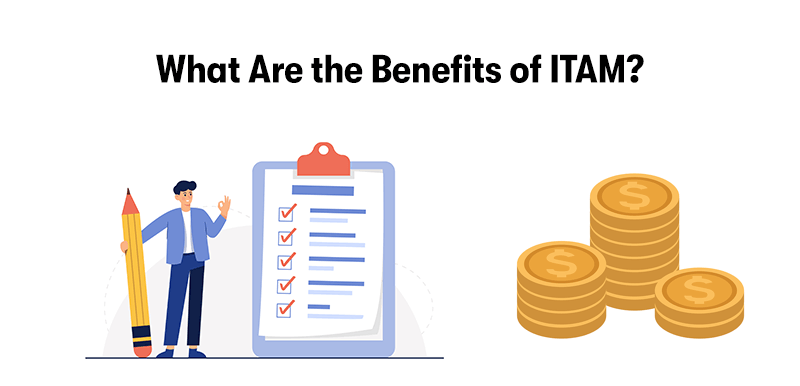
The benefits of IT Asset Management (ITAM) are wide-ranging and impact various aspects of an organisation's operations, financial management, and strategic planning. Here's a comprehensive look at these benefits:
Cost Savings and Financial Control
Reduced Capital Expenditure: ITAM helps identify unnecessary purchases, thereby reducing capital expenses.
Optimised Operating Expenses: By managing the maintenance and operation of IT assets efficiently, operating costs are minimised.
Better Budgeting and Forecasting: Accurate asset data aids in more precise budgeting and financial forecasting.
Risk Reduction and Compliance
Minimised Compliance Risks: Ensures compliance with software licensing, reducing the risk of legal issues and financial penalties.
Enhanced Security Posture: Helps identify and mitigate security risks associated with IT assets.
Adherence to Regulations: Complying with various industry and data protection regulations.
Operational Efficiency
Improved Asset Utilisation: Ensures all assets are being used to their full potential, avoiding redundancy.
Reduced Downtime: Regular maintenance and timely updates reduce the risk of asset failure and downtime.
Streamlined Processes: Facilitates more efficient asset management processes, saving time and resources.
Strategic IT Management
Data-Driven Decision Making: Provides insights for informed decision-making regarding IT strategies and investments.
Alignment with Business Objectives: Ensures IT assets directly contribute to achieving business goals.
Lifecycle Management
Effective Asset Lifecycle Management: Manages the entire lifecycle of assets, from acquisition to disposal, ensuring maximum value extraction.
Sustainable Practices: Promotes environmentally responsible disposal and recycling of IT equipment.
Asset Visibility and Governance
Improved Asset Tracking and Visibility: Maintains an accurate and real-time inventory of IT assets.
Enhanced Governance: Establishes clear policies and procedures for IT asset management, improving overall governance.
Support for IT Service Management
Better Service Delivery: ITAM data supports IT service management, improving service delivery and support.
Integration with ITSM Processes: Aligns with ITSM for a more holistic approach to IT management.
Data Protection and Privacy
Protection of Sensitive Information: Secures assets that store or process sensitive data.
Compliance with Privacy Laws: Aids in managing personal data assets in compliance with privacy laws.
Vendor Management
Effective Vendor Relationships: Provides leverage in vendor negotiations and management of service-level agreements.
Informed Purchasing Decisions: Assists in making better decisions about purchasing and renewing IT assets.
ITAM brings a structured approach to managing IT assets, enhancing operational efficiencies, reducing costs, ensuring compliance, and supporting strategic decision-making. This comprehensive management of IT assets is crucial for modern organisations to maximise the value of their IT investments while minimising associated risks and costs.
What Does the Process of Managing IT Assets Look Like?
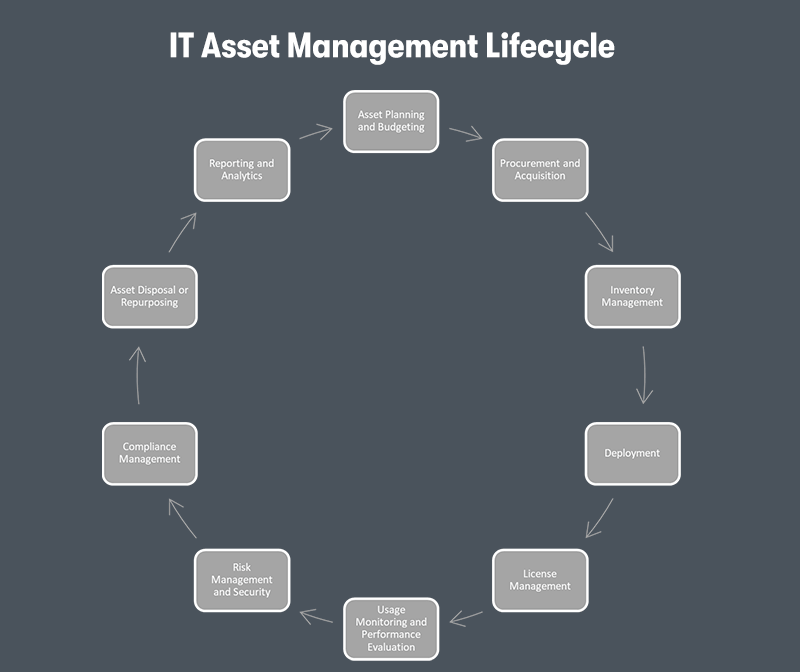
Managing IT assets is a multifaceted process that involves a series of interconnected steps, each crucial for ensuring the effective and efficient use of IT resources. Here's an overview of what the process typically looks like:
1. Asset Planning and Budgeting
Needs Assessment: Identifying the IT requirements of the organisation based on current and future business objectives.
Budget Allocation: Allocating funds for the procurement, maintenance, and management of IT assets.
2. Procurement and Acquisition
Vendor Selection and Negotiation: Choosing vendors and negotiating terms for purchasing or leasing IT assets.
Purchase or Lease: Acquiring the assets through direct purchase, leasing, or other financial arrangements.
3. Inventory Management
Asset Registration: Recording new assets in an inventory management system with details like specifications, purchase date, and cost.
Asset Tagging and Tracking: Using barcodes, RFID tags, or other technologies to facilitate the tracking of physical assets.
4. Deployment
Configuration and Installation: Setting up hardware and software according to organisational needs.
User Allocation: Assign assets to users or departments and ensure they are aware of usage policies.
5. License Management
Software License Tracking: Monitoring software licenses to ensure compliance and optimal utilisation.
Renewal Management: Managing renewals, updates, and compliance of software licenses.
6. Maintenance and Support
Regular Maintenance: Performing scheduled maintenance to ensure assets are functioning optimally.
Helpdesk and Support: Providing support for any issues or queries related to IT assets.
7. Usage Monitoring and Performance Evaluation
Usage Tracking: Monitoring how assets are being used and by whom.
Performance Analysis: Evaluating the performance of assets to identify any issues or the need for upgrades.
8. Risk Management and Security
Security Measures: Implementing security protocols to protect assets from cyber threats.
Risk Assessment: Regularly assessing risks associated with IT assets.
9. Compliance Management
Regulatory Compliance: Ensuring all assets comply with relevant laws, standards, and policies.
Audit Preparation: Maintaining proper records and documentation for internal and external audits.
10. Asset Disposal or Repurposing
End-of-Life Management: Deciding when an asset is no longer useful or cost-effective to maintain.
Disposal: Securely and responsibly dispose of assets or repurpose them if feasible.
11. Reporting and Analytics
Data Analysis: Analysing data collected from IT assets for insights into usage patterns, costs, and efficiencies.
Reporting: Creating reports for stakeholders to provide visibility into asset management performance.
This process is cyclical and ongoing, ensuring continuous alignment of IT assets with the organisation's evolving needs. Effective IT asset management helps maximise the value derived from IT investments and plays a crucial role in strategic planning, risk management, and overall organisational efficiency.
What Software Can be Used for Asset Management?
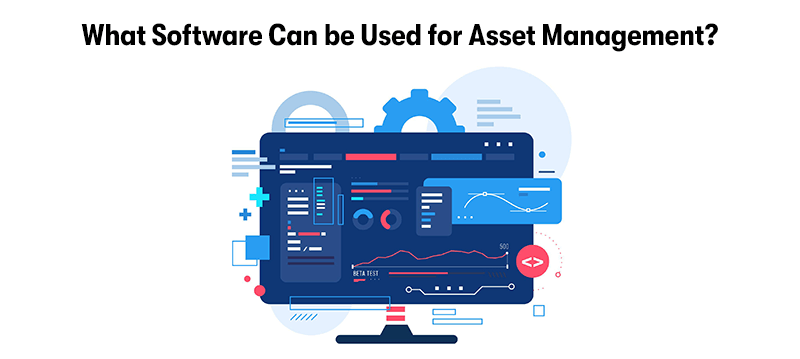
There are numerous software solutions available for asset management, each offering different features and capabilities to suit various organisational needs. Here's a list of some widely used asset management software:
ServiceNow
Overview: A comprehensive IT service management tool with robust IT asset management features.
Key Features: Asset tracking, contract management, compliance tracking, and integration with IT service management.
BMC Helix ITSM
Overview: Offers advanced IT service management capabilities along with IT asset management.
Key Features: Configuration management database (CMDB), asset discovery and tracking, and lifecycle management.
Ivanti Asset Manager
Overview: Designed for managing both hardware and software assets efficiently.
Key Features: Asset tracking, lifecycle management, license management, and comprehensive reporting tools.
IBM Maximo
Overview: An enterprise asset management tool known for its extensive features and scalability.
Key Features: Asset lifecycle management, maintenance scheduling, inventory management, and procurement.
ManageEngine AssetExplorer
Overview: A web-based IT asset management tool suitable for small to large enterprises.
Key Features: Hardware and software tracking, purchase order management, license compliance, and comprehensive ITAM reports.
SAP Asset Management
Overview: Part of the SAP Enterprise Resource Planning (ERP) suite, offering integrated asset management.
Key Features: Real-time asset tracking, predictive maintenance, and integration with other SAP modules.
SolarWinds Service Desk
Overview: An IT service desk solution with integrated IT asset management functionality.
Key Features: IT asset tracking, risk detection, configuration management, and automated asset discovery.
Asset Panda
Overview: A flexible and customisable asset tracking platform suitable for various types of assets.
Key Features: Barcode scanning, custom reporting, asset lifecycle management, and mobile app accessibility.
Spiceworks IT Asset Management
Overview: A free tool particularly favoured by small to medium-sized businesses.
Key Features: Network scanning, inventory management, and integration with other Spiceworks tools.
Lansweeper
Overview: An IT Asset Management tool known for its robust asset discovery and inventory capabilities.
Key Features: Network discovery, software inventory, IT asset reporting, and compliance tracking.
Considerations When Choosing Software
Scalability: The software should be able to grow with your business.
Integration: It should integrate well with your organisation's other systems and tools.
User Interface: Look for a user-friendly and intuitive interface.
Customisation: The ability to customise features and reports to meet specific needs.
Support and Training: Adequate customer support and training resources are essential for effective implementation.
The choice of asset management software depends on the specific needs and size of your organisation and the complexity of your IT environment. Many of these solutions offer free trials or demos, allowing businesses to evaluate their features and compatibility before making a decision.
ITAM vs ITSM - What's the Difference?
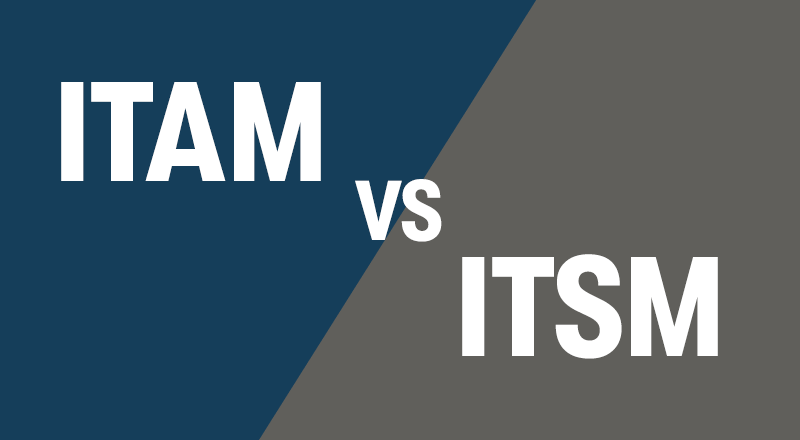
IT Asset Management (ITAM) and IT Service Management (ITSM) are crucial components of an organisation's IT framework, but they focus on different aspects of IT operations. Understanding the differences between them is essential for implementing effective IT strategies.
IT Asset Management (ITAM)
Focus: Asset-Centric - Concentrates on the physical and digital assets used in IT operations, like hardware, software, and licenses.
Key Objectives:
- Lifecycle Management: Manages the entire lifecycle of IT assets, from procurement to disposal.
- Cost Control: Focuses on minimising costs associated with acquiring and maintaining IT assets.
- Risk Management: Manages asset usage, compliance, and security risks.
- Inventory Tracking: Maintains an accurate and detailed inventory of all IT assets.
Activities:
- Procurement: Acquiring IT assets.
- Inventory Management: Tracking and managing IT assets.
- License Management: Managing software licenses to ensure compliance.
- Disposal/Recycling: Responsible disposal or recycling of IT assets.
Tools:
- Uses tools for inventory management, asset tracking, and license management.
IT Service Management (ITSM)
Focus: Service-Centric - Focuses on delivering IT services to end-users and the business.
Key Objectives:
- Service Delivery: Ensures efficient and effective delivery of IT services.
- User Satisfaction: Focuses on meeting user needs and improving user experience.
- Process Optimisation: Streamlines and optimises IT service delivery processes.
- Quality Assurance: Maintains high-quality IT services.
Activities:
- Incident Management: Managing and resolving user-reported incidents.
- Change Management: Overseeing changes in the IT environment.
- Problem Management: Identifying and resolving underlying problems causing incidents.
- Service Request Management: Handling service requests like access or new hardware requests.
Tools:
- Uses tools for service desk management, ticketing systems, and process workflow automation.
Overlapping Areas
While ITAM and ITSM have distinct focuses, they overlap and interact in several areas:
Asset Information for Service Management: ITSM uses asset information from ITAM to resolve incidents and manage changes.
Asset Utilisation for Service Improvement: ITAM insights can help optimise the use of assets, impacting service quality in ITSM.
Compliance and Risk Management: Both disciplines contribute to managing compliance and risks in IT operations.
Conclusion of ITAM vs ITSM
Complementary Roles: ITAM and ITSM are complementary, with ITAM providing the asset foundation for ITSM's service-oriented approach.
Integrated Approach: Many organisations benefit from integrating ITAM and ITSM to enhance overall IT operations and service delivery.
In essence, ITAM is about the assets themselves, while ITSM is about the services those assets support. Both are vital for an organisation's IT environment's efficient, cost-effective, and risk-managed operation.
What's the Role of an ITAM Manager?

The role of an IT Asset Manager (ITAM Manager) is critical in managing and optimising an organisation's IT assets. This role encompasses various responsibilities and requires a blend of technical, managerial, and strategic skills. Here's a detailed look at the role of an ITAM Manager:
Asset Lifecycle Management
Overseeing the Entire Asset Lifecycle: From procurement to disposal, ensuring each stage is managed efficiently.
Planning Replacements and Upgrades: Determining when assets need to be upgraded or replaced based on performance and business needs.
Inventory Management
Maintaining Accurate Inventory Records: Ensuring the IT asset inventory is up-to-date, including details of asset specifications, locations, and users.
Conducting Regular Audits: Performing periodic audits to validate inventory records and ensure accuracy.
Financial Management
Budgeting and Cost Control: Managing the budget for IT assets and ensuring cost-effective procurement and maintenance.
Cost Analysis and Reporting: Analysing costs related to IT assets and reporting to management for strategic decision-making.
Compliance and Risk Management
Ensuring Licensing Compliance: Managing software licenses to ensure compliance and avoid legal issues or penalties.
Mitigating Risks: Identifying and mitigating risks related to IT asset usage, including security risks.
Vendor and Contract Management
Negotiating with Vendors: Managing relationships and negotiations with vendors for purchasing and maintaining IT assets.
Managing Contracts and Agreements: Overseeing service level agreements (SLAs) and maintenance contracts.
Strategic Planning and Policy Development
Developing ITAM Strategies and Policies: Establishing and updating ITAM policies and strategies in line with organisational objectives.
Alignment with Business Goals: Ensuring ITAM practices align with and support the broader business goals and strategies.
Integration with Other IT Functions
Collaborating with ITSM and Other Departments: Working closely with IT service management and other departments for a holistic IT approach.
Supporting IT Projects: Providing asset-related insights and support for various IT projects and initiatives.
Technology and Data Management
Implementing ITAM Tools: Selecting and implementing ITAM software tools for efficient asset management.
Data Analysis and Reporting: Analysing data related to IT assets and generating reports for management.
Team Management and Leadership
Leading the ITAM Team: Managing and leading the team responsible for IT asset management.
Training and Development: Ensuring team members are adequately trained and up-to-date with ITAM best practices.
The ITAM Manager ensures that IT assets are managed effectively throughout their lifecycle, contributing to cost savings, risk reduction, and overall IT efficiency. This role requires a comprehensive understanding of the technical and business aspects of IT assets and strong leadership and communication skills.
What is an ITAM Database?
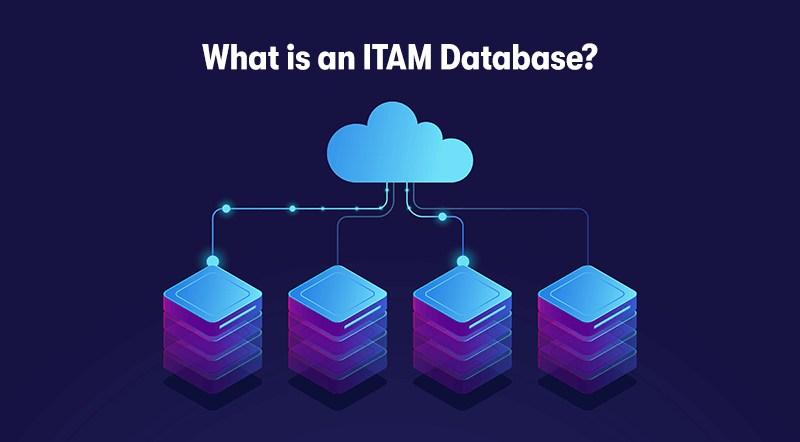
In some contexts, an IT Asset Management (ITAM) database, often referred to as an Asset Repository or Configuration Management Database (CMDB), is a centralised repository that stores detailed information about an organisation's IT assets. This database is a critical component of ITAM practices, providing a comprehensive view of the IT asset landscape. Here's an overview of what an ITAM database typically includes and its functions:
Key Components of an ITAM Database
Asset Details
- Hardware Information: Includes computers, servers, network devices, and peripherals, detailing their make, model, specifications, and serial numbers.
- Software Records: Details about software applications, including versions, licenses, installation dates, and compliance information.
- Service and Contract Information: Service agreements, warranties, and maintenance contracts.
Asset Lifecycle Data
- Procurement Data: Details on purchase orders, vendor information, purchase dates, and costs.
- Deployment Status: Information on how and where assets are deployed within the organisation.
- Maintenance and Upgrade History: Records of maintenance activities, updates, and asset upgrades.
- Disposal Records: Details of asset retirement, including decommissioning dates and disposal methods.
Configuration Data
- Asset Configuration: Settings and configurations for each asset are essential for network devices and servers.
- Interdependencies: Information about how different assets are interconnected or dependent on each other.
Usage and Performance Metrics
- Utilisation Data: Information on how assets are being used within the organisation.
- Performance Metrics: Data on the performance of assets, helpful in identifying assets that may need upgrades or replacement.
Functions of an ITAM Database
Inventory Management
Inventory Management provides a centralised view of all IT assets, making managing and tracking them more accessible.
Decision Support
Decision Support offers data-driven insights for IT decision-making, such as procurement, asset optimisation, and lifecycle management.
Compliance and Audit Readiness
Facilitates compliance with software licensing and regulatory requirements and prepares for internal or external audits.
Risk Management
Assists in identifying and managing risks related to IT assets, including security vulnerabilities.
Cost Management
Helps track and analyse IT asset costs, contributing to more effective budgeting and cost-saving strategies.
Operational Efficiency
Enhances operational efficiency by providing accurate and immediate information about assets, thus reducing downtime and improving asset utilisation.
An ITAM database is essential for effective asset management, acting as the backbone of ITAM processes. It ensures that all asset-related information is stored, managed, and accessible in a structured manner, supporting various ITAM activities and decision-making processes. For large organisations or those with complex IT environments, an ITAM database is crucial for maintaining control and visibility over their extensive IT assets.
How Does ITAM Relate to Hardware and Software?
IT Asset Management is closely related to hardware and software assets within an organisation, managing these assets throughout their lifecycle to ensure they are efficiently and effectively used, maintained, and accounted for. Here's how ITAM relates to both hardware and software:
Relation to Hardware
Asset Tracking and Inventory
- Identification and Cataloguing: ITAM involves identifying and cataloguing all hardware assets, like computers, servers, network devices, and peripherals.
- Inventory Management: Keeping a detailed and up-to-date hardware inventory, including location, status, and user information.
Lifecycle Management
- Procurement and Deployment: Managing the acquisition and deployment of hardware assets.
- Maintenance and Upgrades: Schedule regular maintenance and manage upgrades to ensure hardware remains functional and up-to-date.
- Disposal and Recycling: Overseeing the responsible disposal or recycling of hardware at the end of its lifecycle.
Cost Management
- Budgeting and Cost Tracking: Monitoring hardware procurement, maintenance, and operation costs.
- Optimisation of Hardware Utilisation: Ensuring that hardware is used efficiently and not underutilised or wasted.
Risk Management
- Security: Implementing security measures for hardware assets, such as access controls and physical security.
- Compliance: Ensuring hardware compliance with relevant regulations and standards.
Relation to Software
License Management
- Tracking and Compliance: Monitoring software licenses to ensure compliance with legal agreements.
- Optimising License Usage: Ensure licenses are fully utilised but not exceeded to avoid underutilisation and non-compliance penalties.
Software Inventory
- Documentation of Software Assets: Maintaining an inventory of all software assets, including versions, installation dates, and usage data.
- Software Deployment: Managing the deployment of software across the organisation.
Lifecycle Management
- Updates and Upgrades: Managing software updates and upgrades to ensure functionality and security.
- End-of-Life Management: Retiring software that is obsolete or no longer needed.
Cost Management
- Budgeting for Software Purchases: Planning and allocating budget for new software acquisitions and renewals.
- Analysing Software Expenditure: Understanding software costs to optimise spending.
Risk Management
- Security Risks: Managing risks associated with software vulnerabilities and ensuring software is up-to-date to mitigate security threats.
- Audit Preparedness: Ensuring readiness for audits related to software licensing and usage.
In essence, ITAM provides a structured approach to managing both hardware and software assets. It ensures these assets are acquired, used, maintained, and disposed of to maximise their value and align with the organisation's overall IT strategy and business goals. By effectively managing these assets, ITAM contributes to cost savings, risk reduction, enhanced productivity, and improved IT resource management.
What is ITAM Disposal?
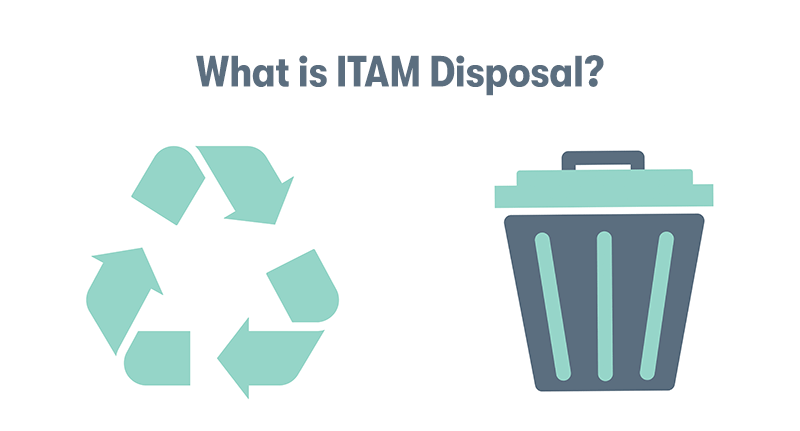
ITAM disposal refers to the safe and responsible disposal of IT assets that are no longer needed, practical, or functional. This stage is a critical part of the IT asset lifecycle and involves several key considerations and steps to ensure that disposal is handled efficiently, securely, and in compliance with legal and environmental standards. Key Aspects of ITAM Disposal include:
Identification of End-of-Life Assets
- Determining which assets have reached the end of their useful life or are no longer cost-effective to maintain.
Data Security and Sanitisation
- Data Wiping: Securely erase all data stored on devices to prevent data breaches or unauthorised access to sensitive information.
- Physical Destruction: In cases where data wiping is not sufficient, physical destruction of storage devices may be necessary.
Compliance with Legal and Environmental Regulations
- Adhering to laws and regulations regarding electronic waste (e-waste), including recycling and disposal methods.
- Ensuring compliance with data protection laws, such as GDPR or HIPAA, during disposal.
Recycling and Repurposing
- Evaluate if any components of the disposed assets can be recycled or repurposed, either within or outside the organisation.
- Working with certified recyclers to ensure environmentally responsible disposal of e-waste.
Documentation and Record Keeping
- Maintaining detailed records of the disposal process, including what has been disposed of, how, and when.
- Keeping track of serial numbers and asset tags to ensure they are properly retired from the ITAM system.
Vendor Management
- In some cases, organisations may outsource the disposal process to third-party vendors specialising in secure and compliant disposal of IT assets.
- Managing these vendor relationships ensures they adhere to the same standards and regulations.
Importance of ITAM Disposal
- Risk Mitigation: Proper disposal mitigates risks related to data security and regulatory non-compliance.
- Cost Management: Efficient disposal can reduce costs associated with storing or maintaining obsolete equipment.
- Sustainability: Environmentally responsible disposal aligns with corporate sustainability goals and social responsibility.
ITAM disposal is a crucial but often overlooked aspect of IT asset management. It requires careful planning, robust processes, and adherence to legal and environmental standards to ensure that the disposal of IT assets are handled in a way that minimises risk, protects sensitive data, and supports sustainability initiatives.
What Are the Best Practices for ITAM?
Adopting best practices in ITAM is essential for maximising the value of IT assets, ensuring compliance, and minimising risks associated with IT investments. Here are some of the best practices for effective ITAM:
Develop a Comprehensive ITAM Strategy
Alignment with Business Objectives: Ensure ITAM practices align with the organisation's overall business goals.
Long-Term Planning: Create a long-term ITAM strategy that includes lifecycle management, risk management, and cost optimisation.
Maintain Accurate Asset Inventory
Regular Updates: Continuously update the asset inventory to reflect new acquisitions, disposals, and changes.
Detail-Oriented Records: Keep detailed records, including specifications, procurement data, and location for each asset.
Implement Effective Lifecycle Management
Proactive Approach: Manage each stage of the asset lifecycle proactively, from procurement to disposal.
Plan for End-of-Life: Have clear policies for when and how to retire assets.
Ensure Compliance and License Management
Software License Compliance: Regularly review and manage software licenses to avoid non-compliance penalties.
Stay Informed on Regulatory Changes: Keep up-to-date with changes in compliance regulations that affect IT assets.
Utilise ITAM Software and Tools
Invest in ITAM Solutions: Use specialised ITAM software for tracking, managing, and reporting on IT assets.
Automate Where Possible: Automate asset tracking and management processes to reduce errors and save time.
Risk Management and Security
Regular Risk Assessments: Conduct periodic risk assessments of IT assets.
Secure Data: Implement robust data security measures, especially for data-bearing assets.
Vendor Management
Build Strong Vendor Relationships: Establish and maintain good relationships with vendors for better service and terms.
Negotiate Favourable Terms: Actively negotiate contracts and SLAs to ensure they meet organisational needs.
Training and Awareness
Educate Staff: Ensure that all relevant staff are trained and aware of ITAM policies and procedures.
Promote ITAM Culture: Encourage a culture that recognises the importance of ITAM across the organisation.
Regular Audits and Reporting
Conduct ITAM Audits: Regularly audit ITAM practices and processes for effectiveness and compliance.
Data-Driven Decision Making: Use reports and analytics for informed decision-making in IT strategy.
Sustainability and Eco-Friendly Disposal
Environmentally Responsible Disposal: Ensure the eco-friendly disposal of IT assets.
Promote Recycling and Reuse: Encourage the recycling and repurposing of IT assets where possible.
Implementing these best practices in ITAM can significantly improve an organisation's IT operations' efficiency, compliance, and cost-effectiveness. A well-structured ITAM process supports operational needs and contributes to strategic objectives and risk management.
Where Can You Learn More About ITAM?
Our IT Asset Management (ITAM) Foundation training course will teach you about the four key ITAM areas and their interaction in relation to contract management, compliance, information security, cost control and IT business value. It focuses on:
- Hardware Asset Management
- Software Asset Management
- Services & Cloud Asset Management
- People and Information Asset Management (including Bring Your Own Device)

Final Notes on ITAM (IT Asset Management)
In conclusion, our IT Asset Management (ITAM) exploration has unveiled its multifaceted nature, highlighting its indispensable role in modern organisations. We've delved into the intricacies of ITAM, underscoring how it encompasses the meticulous management of hardware and software assets through their entire lifecycle. By emphasising best practices, including comprehensive strategy development, meticulous inventory management, effective lifecycle management, and robust compliance adherence, we've illuminated pathways for organisations to optimise their IT investments.
Moreover, the critical role of ITAM in ensuring cost efficiency, risk mitigation, and alignment with business objectives can't be overstated. As we navigate an increasingly digital world, the principles and practices of ITAM provide a foundational framework for organisations to harness the full potential of their IT resources. Thus, ITAM emerges as a functional necessity and a strategic asset in the ever-evolving business technology landscape.
Stay tuned for more insights and in-depth analyses on key business technologies and practices right here on our blog.


